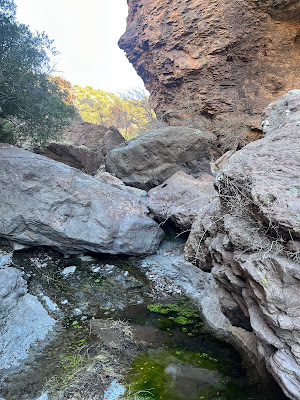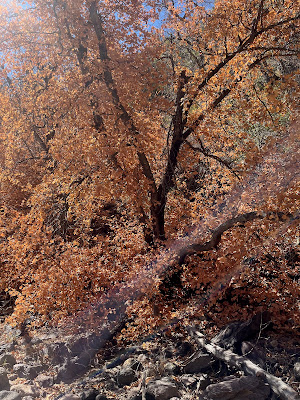Apache Box Wilderness Study Area
 |
| Luke Koenig at the boulder where we stopped. |
 |
| Large pool on Apache Creek |
 |
| Sycamore |
 |
| Luke Koenig photographing the arch |
 |
| Luke beneath an alcove that was actually a natural arch |
 |
| Luke checking out a side canyon. |
Visiting place like this. . . keeps the explorer inside me alive.
I first came across the Apache Box WSA several years ago looking at an old map of New Mexico Wilderness and Wilderness Study Areas. At that time it was only the 800 or so acres of the box canyon itself, but it has since increased to over 6000 acres of surrounding BLM lands.
I had the idea to start visiting many of the lesser known areas I saw on the map. One of the first ones I visited was the Horse Mountain WSA. I now have a cabin ( on private property of course) at Horse Mountain on Wilderness Circle and the actual wilderness entrance is less than a mile down the road. The idea went on the back-burner for a few years but the next one I went to was Stallion WSA east of Socorro. Once again, the plan rested, but in recent years it's been revived. I've done several treks into the Florida Mountains WSA and one into the Continental Divide WSA. In December I went out with NM Wild volunteers to the very obscure Cedar Mountains WSA and one month ago I went out with Luke Koenig of NM Wild to see what we could see in the Apache Box WSA- the subject of this blog.
We followed the access directions laid out by the BLM more or less. Following a fence line up and down steep rocky hills to avoid private property was not at all fun or scenic, although Luke spotted a nice obsidian projectile point early on. Even though the line distance was short, it was taking up a much bigger chunk of time than I had anticipated, but finally we were at a corner where we could cross over onto New Mexico State Trust Land. It was more of the steep rocky in out of couple of gullies as we headed south down to Apache Creek. On one hill we got glimpse of the cliffs at the mouth of the box shining in the morning sun.We found a tiny amount of icy water in minuscule side drainage right along the fence and proceeded to climb down the rocks, occasionally stepping off to the side when the way was vaguely clear. It wasn't a good choice, and was even more miserable on the way back up, but it got us down to the canyon.
A good part of the magic of canyons like these, and this canyon has many commonalities with others to the east in the Gila and Aldo Leopold Wildernesses, is in the powerful contrast to the surrounding country. The dry PJ country we had trudged through was quickly swiped at the sight of sycamores and deciduous oaks even though they hadn't even greened up yet. Then there was water, first just a few puddles filled with last fall's sycamore and oak leaves, but then flowing through willow thickets and over bedrock. As dry as it has been, and given that when you walk out the bottom of this box canyon you are in bonafide desert, it seem a miracle.
The cliffs, at times stiff and straight, but then wonderfully wavy, rose up and seemed to bend over the narrow canyon. It seemed impossible to capture their true massiveness in a photo. They would not be contained. I tried and tried but eventually moved on from the idea. Luke lay on his back for some of his shots. I don't know if he were any more successful.
 |
| Apache Box |
 |
| Volcanic cliffs on the south rim of the canyon |
 |
| Luke on his back taking a photo |
The canyon bottom's meager width meant we were almost entirely in shade and blissfully cool all throughout the warmest hours of the day. That constant shade also meant that there were a few big tooth maples tucked away beneath the cliffs.
I had had plans to reach the mouth of the box, but when doing my research on Google Earth it was not readily apparent how difficult that would be. What I couldn't see in the shadows or through the greened trees of the images were the boulders. The hike changed from pleasant scrambling along the clear waters of the stream, to maneuvering around, over, down and through the many, many gigantic boulders in our way. The pauses to contemplate the best route increased significantly and slowed our progress to the bottom to a (literal) crawl at times.
Maybe young Luke could have made it down and back before dark without the old man along, I don't know. We called it day standing atop a huge boulder gazing out over the live oaks and bare sycamores to the wall of cliffs that bent toward the opening and the end ( or beginning ) of the box, but we were never in a position to see the opening itself.
Getting back up to a place where we could take a few level steps was unpleasant. I am grateful to Luke for yanking me up more than once as my stamina began to fade. I may have had more energy if not for the sapping of it by the tedious and tiresome approach to the canyon, and now I had that to look forward to on the return. It was a blessing to have a companion to talk with when the time came.
A cactus thorn penetrated the toe of my boot. The situation had to be remedied. We sat and rested while I did the work to remove it. It wasn't that easy and I ended up cutting a hole in the rubber to get it out. It was bye-bye boots when I got back home. They had already passed my usual one year expiration date anyway. I fell a few times.Luke may have fallen too. Peace seemed to settle on the Mule Creek Valley with the fading light and the growing shadows as we drove away from the canyon. Beautiful New Mexico day.
I had been to a place that brought me joy.
Labels: fall colors, hiking, natural arches











































0 Comments:
Post a Comment
Subscribe to Post Comments [Atom]
<< Home